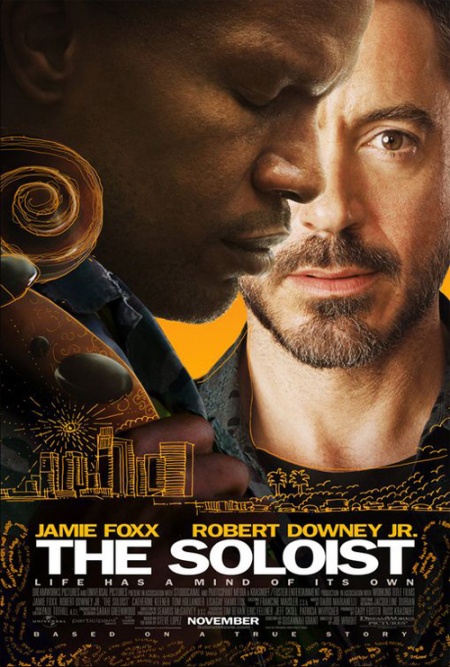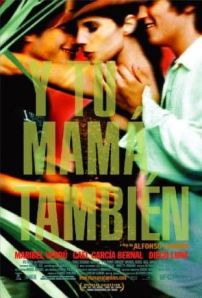 Today is Saturday, August 29, 2009, and I am currently watching a film called The Soloist. It’s a film that came out late last year, I believe, and its main actors are Robert Downey Jr. and Jamie Foxx. The film is about a homeless musician named Nathaniel Avery (Foxx) and an LA Times writer named Steve Lopez (Downey) who writes about how a Julliard alum ended up on the street.
Today is Saturday, August 29, 2009, and I am currently watching a film called The Soloist. It’s a film that came out late last year, I believe, and its main actors are Robert Downey Jr. and Jamie Foxx. The film is about a homeless musician named Nathaniel Avery (Foxx) and an LA Times writer named Steve Lopez (Downey) who writes about how a Julliard alum ended up on the street.
I am currently 43 minutes into the film, and Nathaniel playing the cello. I have to pause now, though, so that I can watch the film.
There is a scene in this film that I instantly felt strongly about. It was a wonderful execution of the director’s interpretative POV. In the scene I am referring to, Steve brought Nathaniel to Walt Disney hall to watch an orchestra rehearse Beethoven’s Third Symphony. As the two men sit alone in the audience, every seat covered with white linens before the actual show, we, the audience, are shown Nathaniel as he reacts to the music that is being played before him. His breathing gets heavier, his fingers softly tap to the rhythm, and then the next shot shows him, alone, surrounded by blackness; he is alone with the music. And Nathaniel closes his eyes. Then, against the black screen come different lights, colourful, flashing in and out with the music’s strong notes and crescendos and, well, I’m not very good with musical terms, but think of it as a visualization on iTunes or Windows Media Player. These flashing colours are a visual synthesia of how Nathaniel sees the music in his head, and this goes on for a while. At the end of the piece, there is blackness, and Nathaniel says, “He’s in the room”. Who is? “Beethoven.”
At some point while watching the film, I began to question its title. The Soloist. The inevitable, instant reaction to this title is that the soloist is Nathaniel Ayers, the musician, who plays Beethoven solos inside a Los Angeles tunnel. However, at some point in the film, the title begins to seem ambiguous, because it could also refer to Steve Lopez, the lonely divorcee who doesn’t want to be the only thing that Nathaniel has in the world that isn’t completely messed up. In a way I saw Steve’s character as a soloist as well, wherein “solo” doesn’t refer to the musical context of the word, but, rather, as a word that refers to being alone.
An hour and fifty minutes in, the film is over, the credits are rolling while classical music plays in the background. As I watched the film I typed notes onto two separate windows, hoping to discover what this film is truly about. My notes ranged from compassion to passion to commitment, to friendship. This film revolves around an enigmatic friendship between two highly unlikely characters. Theme ideas moved to poverty. Injustice. Fragility. The fragility of life, of relationships, friendship. Of the mind. Cause and effect, effects and their causes.
At the end of the film, however, I think that Downey, as Steve Lopez, phrased the main theme of this film perfectly, through his last voiceover narrating the contents of his L. A. Times column, “Point West”. He refers to it as, quote, “the dignity of being loyal to something you believe in”. This phrase beautifully captures the very essence of what the film has been talking about all along. I believe that The Soloist sends this message powerfully and effectively in a very emotionally engaging manner. Downey and Foxx both delivered stellar performances, playing the roles of two characters that were both so easy to empathise with. I really enjoyed their performances in this film, and, while it only increased my eternal admiration for Robert Downey Jr.’s talent, it allowed me to appreciate Jamie Foxx more as an actor, since I have barely seen any of his films and I usually see him on MTV as a singer rather than an actor. He’s a brilliant actor!
One thing that I found useful about watching The Soloist is that I just might have an idea or two for my independent study topic. I’ve been considering how different cultures respond to breaking conventional, blockbuster cinema. I’m basically referring to indie film culture and defining what an “indie film” is besides the idea of being produced by a minor or independent film company. After seeing this film, though, I’ve also started to consider talking about the depiction of poverty and the use of voiceovers, characteristics that are common in both The Soloist and Y Tu Mamá También, which are two films I’ve seen within the last 24 hours. Blindness also applies to the “poverty” concept. Anyway, we’ll see.
 Today is Saturday, August 29, 2009, and I am currently watching a film called The Soloist. It’s a film that came out late last year, I believe, and its main actors are Robert Downey Jr. and Jamie Foxx. The film is about a homeless musician named Nathaniel Avery (Foxx) and an LA Times writer named Steve Lopez (Downey) who writes about how a Julliard alum ended up on the street.
Today is Saturday, August 29, 2009, and I am currently watching a film called The Soloist. It’s a film that came out late last year, I believe, and its main actors are Robert Downey Jr. and Jamie Foxx. The film is about a homeless musician named Nathaniel Avery (Foxx) and an LA Times writer named Steve Lopez (Downey) who writes about how a Julliard alum ended up on the street. Today is Saturday, August 29, 2009 and last night I stayed up until 2 in the morning secretly watching Y Tu Mamá También, starring Dieego Luna and Gael Garcia Bernal. I borrowed this film on from the media center in school as part of what I wanted to call a “Gael” binge, following two Sundays ago when I watched Blindness (2008). Finding the DVDs was a coincidence, though. My initial intention was actually to rent out Mike Leigh’s Naked (1993) for my Online Analysis assignment for IB Film. However, when I didn’t see it, I found instead three DVDs for Spanish-language films, all of which starred Gael Garcia Bernal: Amores Perros, Diarias de Motorcicleta and Y Tu Mamá También. I decided to borrow these three films just in case I find some sort of inspiration for my independent study.
Today is Saturday, August 29, 2009 and last night I stayed up until 2 in the morning secretly watching Y Tu Mamá También, starring Dieego Luna and Gael Garcia Bernal. I borrowed this film on from the media center in school as part of what I wanted to call a “Gael” binge, following two Sundays ago when I watched Blindness (2008). Finding the DVDs was a coincidence, though. My initial intention was actually to rent out Mike Leigh’s Naked (1993) for my Online Analysis assignment for IB Film. However, when I didn’t see it, I found instead three DVDs for Spanish-language films, all of which starred Gael Garcia Bernal: Amores Perros, Diarias de Motorcicleta and Y Tu Mamá También. I decided to borrow these three films just in case I find some sort of inspiration for my independent study.